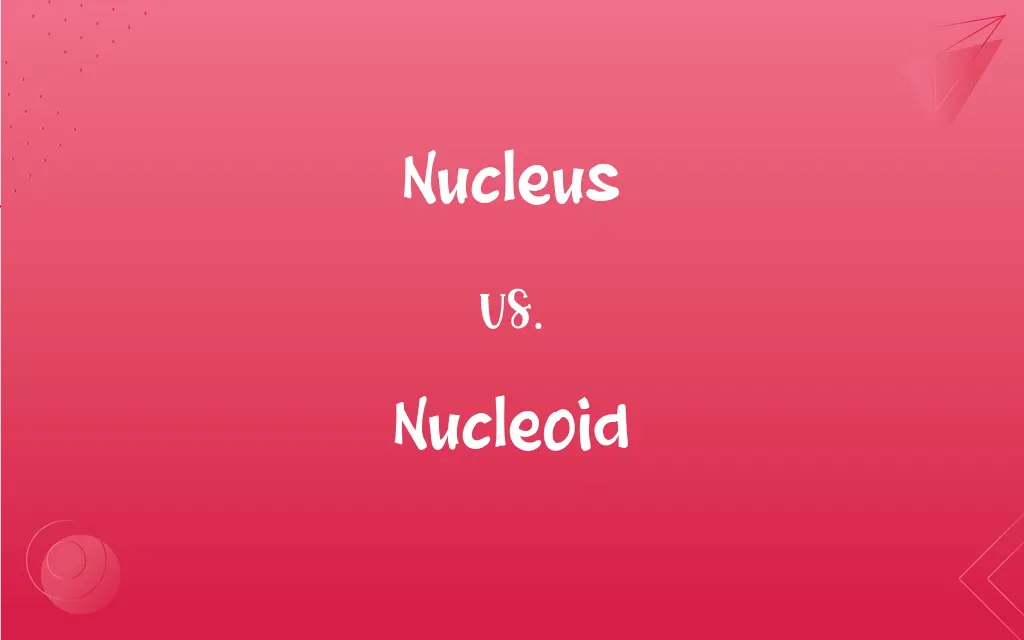Nucleus vs. Nucleoid: What's the Difference?
Edited by Janet White || By Harlon Moss || Updated on October 28, 2023
The nucleus is a membrane-bound organelle found in eukaryotic cells containing genetic material, while the nucleoid is an irregularly shaped region within prokaryotic cells that holds the genetic material.

Key Differences
When one speaks of the nucleus, they are referring to a distinct, membrane-bound organelle found in eukaryotic cells. This membrane, known as the nuclear envelope, encases the genetic material, ensuring it remains separated from the cytoplasm. On the other hand, the nucleoid is characteristic of prokaryotic cells and lacks a surrounding membrane. This means the genetic material within the nucleoid directly mingles with the cytoplasm.
The nucleus is not just a passive container for DNA. It plays a crucial role in the regulation of gene expression, ensuring that genes are turned on or off as needed. The nucleoid, while not membrane-bound, still holds a vital function. It tightly compacts the genetic material of prokaryotic cells, ensuring efficient replication and transcription processes.
Within the nucleus, the genetic material exists in the form of chromatin, which further condenses to form chromosomes during cell division. These structures allow for the organized separation of DNA during mitosis. In contrast, the nucleoid comprises a single, circular DNA molecule that doesn't form chromosomes in the traditional sense.
The presence of a nucleus is often used as a distinguishing factor between eukaryotic and prokaryotic cells. Eukaryotic cells, including those of animals, plants, and fungi, possess a nucleus. Prokaryotic cells, such as bacteria, don't have a nucleus but instead have a nucleoid where their genetic material resides.
Another stark difference between the nucleus and nucleoid is their interaction with cellular machinery. The nucleus has nuclear pores allowing for the exchange of molecules, like RNA and proteins, between the nucleus and cytoplasm. Since the nucleoid isn't bound by a membrane, there's a direct interaction between genetic material and the cytoplasm in prokaryotic cells.
ADVERTISEMENT
Comparison Chart
Presence
In eukaryotic cells
In prokaryotic cells
Membrane-bound
Yes, surrounded by a nuclear envelope
No
Genetic Material
Chromatin or chromosomes
Single, circular DNA molecule
Interaction
Through nuclear pores
Directly with the cytoplasm
Function
Regulation of gene expression, protection of genetic material
Compaction of genetic material, DNA replication
ADVERTISEMENT
Nucleus and Nucleoid Definitions
Nucleus
An organelle where DNA replication and RNA synthesis occur.
Inside the nucleus, the DNA blueprint is transcribed into RNA.
Nucleoid
The center of genetic operations in prokaryotes.
The nucleoid ensures the efficient replication of the bacterium's DNA.
Nucleus
The central organelle in eukaryotic cells that contains genetic material.
The nucleus directs cellular activities by controlling the synthesis of proteins.
Nucleoid
The counterpart of the nucleus in prokaryotic organisms.
While eukaryotic cells have a nucleus, prokaryotes have a nucleoid.
Nucleus
A membrane-bound structure safeguarding DNA.
The nuclear envelope surrounds the nucleus, separating it from the cytoplasm.
Nucleoid
The region in prokaryotic cells containing genetic material.
The bacterium's genetic information is found within the nucleoid.
Nucleus
The control center of the cell.
The nucleus regulates gene expression, ensuring the cell functions correctly.
Nucleoid
An irregularly shaped region holding a circular DNA molecule.
The nucleoid of a bacterial cell contains a single, coiled DNA strand.
Nucleus
A distinguishing feature of eukaryotes.
One major difference between eukaryotic and prokaryotic cells is the presence of a nucleus.
Nucleoid
A non-membrane-bound DNA-containing area.
Unlike the nucleus, the nucleoid doesn't have a surrounding membrane.
Nucleus
A central or essential part around which other parts are gathered or grouped; a core
The nucleus of a city.
Nucleoid
The undefined region of genetic material inside a prokaryotic cell, consisting of aggregated DNA.
Nucleoid
(microbiology) The irregularly-shaped region within a prokaryote cell where the genetic material is localized
FAQs
What's the main function of the nucleus?
The nucleus regulates gene expression and protects genetic material.
Is the nucleoid surrounded by a membrane?
No, the nucleoid is not membrane-bound.
Which cells have a more organized genetic structure, those with a nucleus or nucleoid?
Cells with a nucleus have a more organized genetic structure, with chromatin and chromosomes.
Can eukaryotic cells have multiple nuclei?
Yes, some eukaryotic cells, like muscle cells, can be multinucleated.
What does the nucleoid represent?
The nucleoid is a region in prokaryotic cells where genetic material is located.
Why is the nuclear envelope vital?
The nuclear envelope protects the genetic material and controls the exchange of molecules between the nucleus and cytoplasm.
How do the nucleus and nucleoid differ in DNA replication?
DNA replication in the nucleus involves multiple linear chromosomes, while in the nucleoid, a single circular DNA molecule is replicated.
Is the nucleoid fixed in shape?
No, the nucleoid has an irregular shape and can change based on the cell's state and environmental conditions.
What role does the nucleolus, found within the nucleus, play?
The nucleolus is involved in ribosome synthesis and the assembly of ribosomal RNA.
How does DNA appear in the nucleoid?
In the nucleoid, DNA is present as a single, circular molecule.
Why don't prokaryotic cells need a nucleus?
Prokaryotic cells use the nucleoid to house their genetic material, making a nucleus unnecessary.
How does the nucleoid influence bacterial function?
The nucleoid contains the genetic instructions guiding bacterial growth, reproduction, and response to the environment.
Is the nucleoid the only region of DNA in bacteria?
Mostly yes, but some bacteria also contain plasmids, which are small, circular DNA fragments outside the nucleoid.
What is a nucleus?
The nucleus is a membrane-bound organelle in eukaryotic cells containing genetic material.
Can you find a nucleus in bacteria?
No, bacteria have a nucleoid instead of a nucleus.
What forms the boundary of the nucleus?
The nuclear envelope, a double membrane, surrounds the nucleus.
How do molecules enter and exit the nucleus?
Through nuclear pores in the nuclear envelope.
Can substances freely move in and out of the nucleoid?
Yes, since the nucleoid isn't membrane-bound, molecules can directly interact with it.
What ensures the organized division of genetic material in cells with a nucleus?
Chromosomes ensure the organized division of genetic material during mitosis.
What's the relationship between the nucleus and ribosomes?
The nucleus directs the synthesis of ribosomal RNA (rRNA), which assembles into ribosomes in the cytoplasm.
About Author
Written by
Harlon MossHarlon is a seasoned quality moderator and accomplished content writer for Difference Wiki. An alumnus of the prestigious University of California, he earned his degree in Computer Science. Leveraging his academic background, Harlon brings a meticulous and informed perspective to his work, ensuring content accuracy and excellence.
Edited by
Janet WhiteJanet White has been an esteemed writer and blogger for Difference Wiki. Holding a Master's degree in Science and Medical Journalism from the prestigious Boston University, she has consistently demonstrated her expertise and passion for her field. When she's not immersed in her work, Janet relishes her time exercising, delving into a good book, and cherishing moments with friends and family.































































